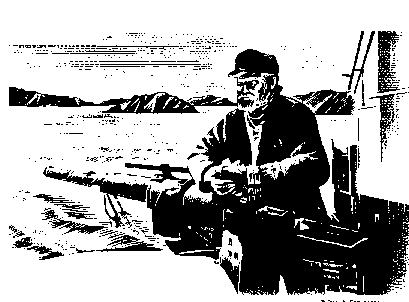 |
REGIONAL INFORMATION DIGESTECONOMY, ECOLOGY, HISTORY, CULTURE |
# 1, 1997
OR BRIMFUL BARRELS OF HERRING...
Igor PSHENICHNIKOV, Lofoten Islands, Oslo.

The times passed when whalers were admired as brave hunters and heroes, chasing the oceanic monsters. Whaling has been for the most part banned or considerably limited for certain whale species. But in spite of that, one country tenaciously advocates its right to go on whaling, thereby single-handedly confronting the rest of the fishing world.
It is Norway. Its position is questionable on many points. But the Vikings will not succumb in the whaling warfare. They provide the arguments of their own against all criticism.
The owner of a small whaling boat Nubren, Ian Odin Ulavsen, should exercise caution more than anybody else. In 1992, two Americans from the Sea Shepherd already tried to sink his boat for killing whales. Ulavsen heads the Alliance of Higher Northern Latitudes, the union of leading organizations of fishermen, whalers, and seal hunters of Norway, Greenland, Faroe Islands and Iceland. He is Enemy #1 for all defendants of whales, while he himself and owners of other 55 whaling boats call themselves just toilers of the sea, whose occupation bears no difference to that of regular "cattle-breeders feeding the stock for slaughter".
"None of them whale advocates can say why the whales are so unique or different from the other animals" says Ulavsen. "All the talks of their mental capabilities and a sort of whale civilization are just a myth. However this one found a fertile soil in the public consciousness, which affects even political decision-making".
In 1996, Norway unilaterally set its whaling quota of 425 whales. On May 18, the U.S. officially protested against the start of whaling season in Norway. Several days earlier, German Minister of Foreign Affairs Klaus Kinkel headed the demonstration of protest in Germany. The Norwegian reaction was relatively calm.
The stumbling block in the emotional exchanges was the small striped whale, by far not the largest of whales (about 10 meters and 8 tons). But this Atlantic wanderer possesses a noteworthy trait: as distinct from other whales, whose menu is made of krill, it is a herring eater of sorts. It devours herring fry in great quantities. The small striped whale stock is estimated at 110000 whales in the Northern Atlantic, discounting about 760000 in the South Atlantic. Norwegians assessed that this kind of stock consumes about 2 million tons of herring annually. "Norway did not catch this much even in the best years" said Ian Henry Ulsen. It is suggested that should the small striped whale population grow, the danger would exist that reserves of herring would be exhausted, even if herring fishing operations were to be stopped temporarily.
Apart from the unfortunate small striped whale, hunted by Norwegians, the world ocean inhabits about 80 whale species differing in size, behavior and eating habits. The largest of all is blue whale reaching 33 meters in length and weighing 150 tons. Hunting for blue whale is totally prohibited. Noteworthy, Norway complies with this prohibitions as well. The smallest is, so called, Toothed whale, which length is a mere 2 meters.
Norwegians say, that there is no longer a talk of scale whaling, which took place in 30-s, 40-s and 50-s throughout the world. Then indeed, the oceans were plowed by floating whaling factories with replacements of tens of thousand metric tons. They killed whales at random for the sake of whale fat, considered a valuable product at that time. Now they make use of small boats. The current landings of today, as compared to those of the floating whaling factories, look very insignificant.
Today, Oslo is getting tired of the round defense and is poised to launch an attack, claiming that Norwegian whalers have all the legal rights to proceed with limited whaling operations. The gist of the Norwegian argumentation is that nobody yet canceled the 1946 Convention on Regulation of Whaling Operations, adopted by 17 nations, and endorsed by International Whaling Commission (IWC). The Convention went about "preservation of whale population with the purpose of balanced development of whaling business", and that "increase in the whale population will lead to increase in whaling quantities".
In 1986, IWC froze the whaling operations for 5 years "in connection with unavailability of the data on the whale population". Norway joined the moratorium since 1987. In 1992, IWC evaluated the small striped whale population in the Northern Atlantic at 87000. Even these understated data, as it was uncovered later, proved, in Norway's point of view, that limited whaling in the Northern Atlantic can continue without damage to the giant whale species. For fairness' sake it should be noted that the Scientific Committee of IWC even issued recommendations concerning the limited whaling operations. However a year later, the same body, which is represented by the United States of America, New Zealand, United Kingdom, Netherlands, and Australia backed out and opposed commercial whaling.
"IWC is ruled by emotions, not scientific evaluation" complained Norwegians, locked out in an absolute minority. In a word, having no support, Norwegians assumed the time had come to stand for their right for traditional business. Norwegian government pointed out at the paradoxicality of the fact that IWC never ever undertook a formal attempt to review the existing Convention, which states in black and white that whaling should be developed. As a result, in 1993, complying with the Convention principles, although without IWO permission, Norway resumed the limited commercial whaling, but with one condition not to export the whale meat.